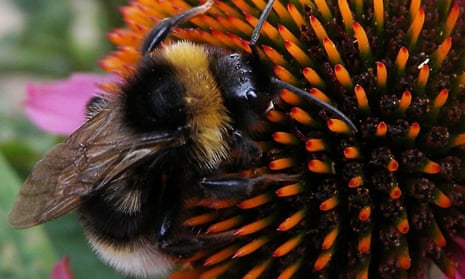Big Bumblebee Discovery
‘The whole family became obsessed’
“Bumblebees are my second favourite insect,” says Connor Abrams, aged 7. He prefers spiders – though in fact he’s a fan of all creepy-crawlies. He was delighted when his school took part in the Big Bumblebee Discovery project earlier this year. In the end, the whole family spent the summer roaming around their home county of Yorkshire, searching for bumblebees.
“We went all over the place, to all the parks, everywhere,” says Connor. The project, set up by EDF Energy in conjunction with the British Science Association, asked participants to record bumblebee sightings on lavender plants to gather detailed data about their behaviour.
The whole family became obsessed. “I’d be looking everywhere I went,” says Connor’s mum Carol Ann. “Even Connor’s grandma was at it.”
About 30,000 people took part in the project, and as a result of their work it was reported that bumblebees are thriving in areas of floral density in urban centres; information which, it is hoped, will encourage planners to include more planting in towns.
The Big Seaweed Search
‘It helps you look at the landscape a little differently’
There are more than 650 types of seaweed around the coast of Britain, and yet our knowledge of them is surprisingly lacking in detail. Scientists at the Natural History Museum and the British Phycological Society, concerned in particular about the presence of wireweed, an invasive species that appears to be spreading, turned to citizen science for help.
The Big Seaweed Search was the result. It gives participants information about 12 different types of seaweed which are common to this country – channelled wrack, spiral wrack, dabberlocks and others – and asks you to identify them and let the centre know.
Careworker Jo Swift takes a group of her patients out about once a week, and wanted something practical and useful for them all to do. “I work with people in a range of ages from their 20s to their 70s, and we’re dealing with lots of different issues: Down’s syndrome, depression and anxiety, general mental health issues. It helps for us to have a focus.”
The Big Seaweed Search was ideal. “You go through the types of seaweed first, then try to identify as many different kinds as possible.” She was particularly keen to look out for the invasive wireweed,
“But we didn’t see any of that. Everyone enjoyed it so much. It helps you look at the landscape a little differently,” says Swift, who has been taking this group out for a few years now. “We always try to do something connected with conservation; I’ve seen over the years what a positive effect it has on the group, and we look forward to it all week.”
Zooniverse
‘I’m seeing parts of the universe I wouldn’t normally have access to’
As soon as she heard about the crowd-sourcing science project Zooniverse, Julia Wilkinson wanted to be part of it.
“I didn’t do science at school, but it was a hobby for many years,” says Wilkinson, who used to manage an advice centre but is now retired. “I had telescopes, I was an amateur astronomer, and Zooniverse offered me the chance to put my astronomy to good use.”
The success of Zooniverse – a huge, online citizen science project – has taken everyone by surprise. It was first set up in 2007 by a team from Oxford university led by Dr Chris Lintott. They had been ploughing through a million images of the universe that had been taken in a digital sky survey, attempting to classify galaxies according to their shape. The human eye is far better at this sort of task than computers, but the process was exhausting and slow. At the time, Lintott was also appearing on the BBC’s Sky at Night programme and decided to ask the public to help him study what he called the Galaxy Zoo.
The response was beyond his wildest dreams. More than 100,000 people signed up, providing more than 40m classifications in 175 days. Two viewers even discovered a new planet. After that, Galaxy Zoo evolved into Zooniverse.org, and there are now dozens more projects being run by the Citizen Science Alliance under the Zooniverse banner.
Members of the public are invited to join in the study of millions of images, helping to identify everything from animals living in the Serengeti to black holes, all from the comfort of their own homes. It is citizen science at its most accessible – all you need to take part is access to a computer.
Wilkinson is currently involved with three different projects, spending a couple of hours most days on the site.
“My favourite at the moment is Solar Stormwatch. You study and monitor images taken by two satellites on either side of the sun. It’s important work because these storms can affect our satellite systems.”
Like many volunteers she loves the fact that she sees parts of the universe she wouldn’t normally have access to. “It’s pretty much a real-time feed, so you’re seeing solar storms almost as they happen. It kind of blows your mind a little.”

Comments (…)
Sign in or create your Guardian account to join the discussion